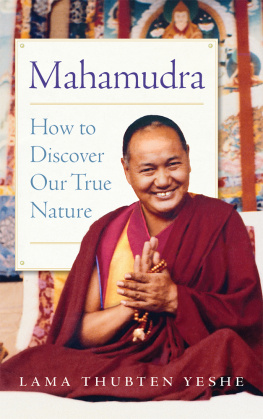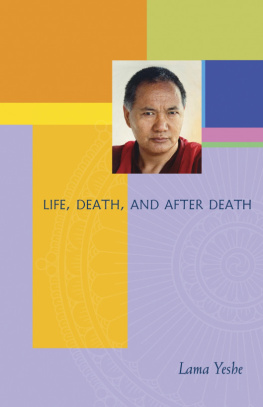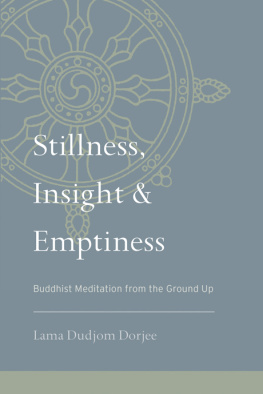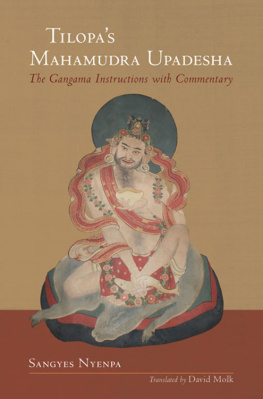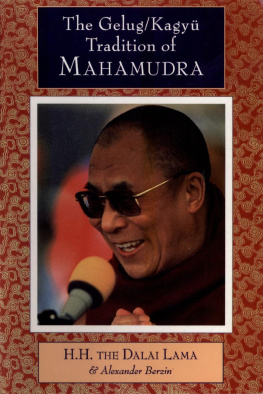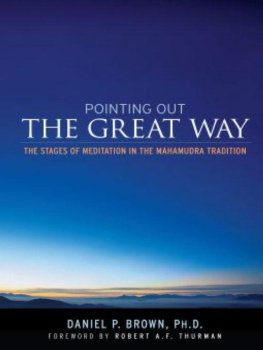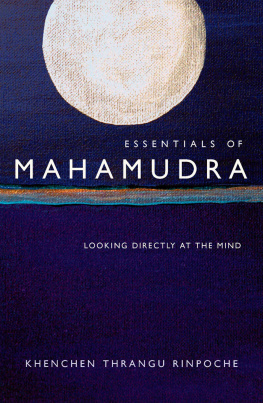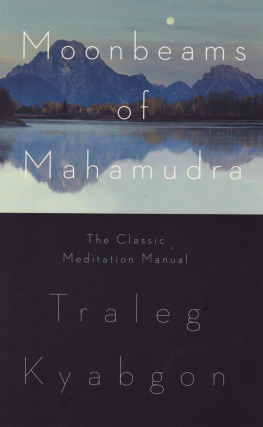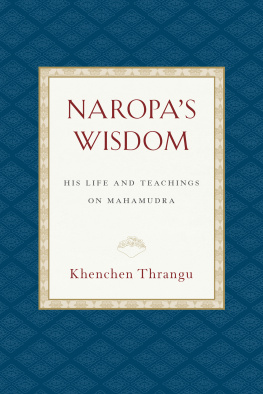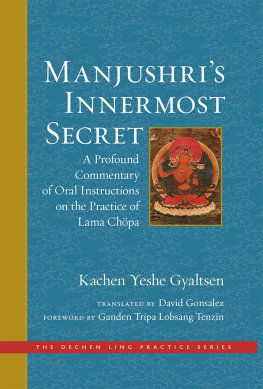
Wisdom Publications, Inc.
199 Elm Street
Somerville MA 02144 USA
wisdompubs.org
2018 Lama Yeshe Wisdom Archive
All rights reserved.
No part of this book may be reproduced in any form or by any means, electronic or mechanical, including photography, recording, or by any information storage and retrieval system or technologies now known or later developed, without permission in writing from the publisher.
Library of Congress Cataloging-in-Publication Data
Names: Thubten Yeshe, 19351984, author. | Blo-bzang-chos-kyi-rgyal-mtshan, Panchen Lama I, 15701662. | Courtin, Robina, editor.
Title: Mahamudra: how to discover our true nature / Lama Thubten Yeshe; edited by Robina Courtin.
Description: Somerville, MA: Wisdom Publications, Inc., 2018. | Includes index. |
Identifiers: LCCN 2017057636 (print) | LCCN 2017061205 (ebook) | ISBN 9781614294108 (ebook) | ISBN 9781614293958 (pbk.: alk. paper) |
Subjects: LCSH: Mahamudra (Tantric rite) | Dge-lugs-pa (Sect) Rituals. | Bka-brgyud-pa (Sect) Rituals.
Classification: LCC BQ8921.M35 (ebook) | LCC BQ8921.M35 T49 2018 (print) | DDC 294.3/4435 dc23
LC record available at https://lccn.loc.gov/2017057636
ISBN 978-1-61429-395-8 ebook ISBN 978-1-61429-410-8
22 21 20 19 18
5 4 3 2 1
Cover design by Gopa & Ted 2. Interior design by Kristin Goble.
Editors Preface
Lama Thubten Yeshe (193584) gave instructions on mahamudra meditation to seventy of his students during a two-week retreat in the Australian winter of 1981, August 215. The host was Atisha Centre, situated on fifty acres of flat, low-growing bushland just west of the small town of Eaglehawk, ninety miles north of Melbourne in the southeastern state of Victoria. The property had been offered to Lama Yeshes Foundation for the Preservation of the Mahayana Tradition (FPMT) earlier that year by the father of Ian Green, one of the students.
Nothing had been built yet, so the retreat was held in a little wooden church next door, in Sandhurst Town, a replica of a village from the mid-nineteenth-century Victorian gold-rush era run by the Green family for tourists. Volunteers did a complete renovation of the churchs interior in time for the event.
Lama paid homage to the great Indian yogi Atisha and to an Australian Atisha:
Atisha Centre has an auspicious name. The great Indian yogi Atisha (9821054), who taught in Tibet during the later years of his life, was successful in his mahamudra practice; he discovered his own mahamudra. From the Tibetan point of view, Atisha was a buddha, an enlightened one.
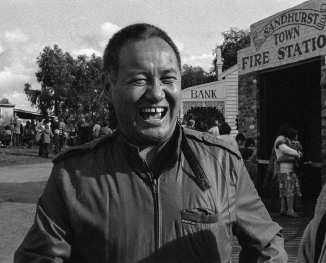
Lama Yeshe in Sandhurst Town, before the retreat. Lamas casual style belies the fact that he was a scholar and a yogi.
This place has the energy of this yogi as well as the energy of an Australian Atisha, the man who offered this facility. He is not Buddhist, but in his heart maybe he is.
The instructions from that two-week retreat form the bulk of this book, supplemented with advice Lama gave at retreats hosted by two of his own FPMT centers, Vajrapani Institute in California in 1977 and Maitreya Instituut in Amsterdam in 1981. Nine months after the Atisha Centre event, in March 1982, Lama also gave advice in India during the first Enlightened Experience Celebration, a marvelous festival of teachings, empowerments, and retreats spanning six months. Organized by Lama Yeshe especially for his Western students hundreds attended many of the teachings and empowerments were given by his own gurus, including His Holiness the Dalai Lama.
He had requested His Holiness to give a commentary on the same text that he himself had used at Atisha Centre, the First Panchen Lama Losang Chokyi Gyaltsens Highway of the Conquerors: The Mahamudra Root Text of the Precious Genden Oral Tradition. (This commentary has since been edited by Alexander Berzin, who translated for His Holiness at the event, and incorporated with other teachings and published as The Gelug/Kagy Tradition of Mahamudra. )
At the retreat, Lama Yeshe explained that mahamudra is a name given to the universal reality of emptiness, of nonduality
the inborn nature of all phenomena. It exists equally in all things: organic, nonorganic, permanent, impermanent, including all beings....
Perhaps youre thinking that if mahamudra is about emptiness, then you have heard it many times before. Youre right; the teachings are not so different. But the unique approach of this presentation is the emphasis on meditation the experience of emptiness rather than explaining what it means.
In mahamudra meditation, Lama says, the object of concentration is our own mind, in particular its clarity, its conventional nature. And, as His Holiness says in his commentary, finally the goal is to realize the emptiness of the mind, its ultimate nature.
If we explain in terms of the [middle way] tradition of a correct view of reality, the usual method for gaining correct understanding is to realize the emptiness of a person a conventional me. For this, we analyze the mode of existence of a person in terms of the five aggregates as the basis for labeling one....
In the mahamudra tradition, however, although we still take as the basis for labeling a person the five aggregates, we focus primarily on the aggregate of consciousness as serving this function. Thus the mahamudra tradition presents a correct view of reality in terms of the emptiness of the mind.
First, however, its necessary to realize the emptiness of ones self. Lama Yeshe says to start by focusing on the thoughts: whatever arises in our mind. When the consciousness settles, we focus on its clarity. Once there is a reasonable level of concentration, in order to recognize that there is no independent self, the Panchen Lama says to investigate intelligently with subtle awareness the essence of the individual who is meditating, just like a small fish that moves in lucid waters without causing any disturbance.
In his commentary, His Holiness explains the next step:
Once we have gained conviction in the lack of true and inherent identity on the basis of our own self, we turn to... other phenomena....
As part of this process, we now take mind as the basis for emptiness in other words, as the basis that is empty of existing in any fantasized and impossible way. We scrutinize and analyze mind with a correct view to gain a decisive understanding of its empty nature.
Throughout the retreat, many of the teachings were given as guided meditations, with Lama emphasizing the experience of emptiness of ones self. He inspired students to go beyond egos addiction to a limited sense of self and to taste the lightness and expansiveness of their own mind, their own very being. As always, his words are not only experiential but also direct, funny, deceptively simple, and incredibly encouraging enlightenment seems possible. And, as always, in his desire to counteract a tendency in contemporary society to mystify meditation, he brings the instructions right down to earth, making them doable even by beginners. He goes to incredible lengths to explain the meaning of what would otherwise remain merely intellectual or arcane.
And there is no limit to Lamas creativity in finding ways to do this. For example, he uses twenty-one different terms for affliction, the main term used in Buddhist psychology which he doesnt use! to refer to states of mind such as attachment, anger, and the primordial clinging to an independent self. Some of the terms are variations of accepted synonyms, but most are his own creation: artificial concept, confused thoughts, contradictory concept, delusion, deluded thought, dualistic concept, dualistic puzzle, dualistic thought, fanatical thinking, fantasy, hallucination, hallucinated projection, hallucinated vision, impure concept, limited concept, misconception, mistaken concept, negative mental energy, projection, superstition, wrong conception.
Next page
